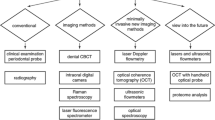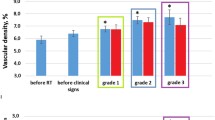Abstract
We report the development of optical coherence tomography- (OCT) based angiography (OCTA) to image blood flow within microcirculatory tissue beds in human oral cavity in vivo with a field of view at 10 mm × 10 mm. Three-dimensional (3D) structural and vascular images of labial mucosa tissue are obtained at a single 3D acquisition. Pathologic mucosal sites with mouth ulcers are examined using the OCT tomograms and angiograms, upon which to monitor the lesion healing process over a period of 2 weeks. Quantitative metrics of the capillary loop density within the lamina propria layer are evaluated, providing statistically significant difference between healthy and diseased conditions over time. Furthermore, tissue anatomy and vessel morphology of other susceptible sites to ulcer, such as tongue, alveolar mucosa, and labial frenulum, are also imaged to demonstrate the promise of the proposed method as a clinically useful tool for the diagnosis and monitoring of therapeutic treatment of oral tissue abnormalities.







Similar content being viewed by others
Reference
American Cancer Society (2017) Cancer Facts & Figures 2017. American Cancer Society, Atlanta
American Cancer Society (2015) Global Cancer Facts & Figures 3rd Edition. American Cancer Society, Atlanta
National Cancer Institute (2011) Cancer Statistics Review 1975–2011: Introduction. https://seer.cancer.gov/archive/csr/1975_2011/results_merged/sect_01_overview.pdf
Squier CA, Kremer MJ (2001) Biology of oral mucosa and esophagus. J Natl Cancer Inst Monogr 29:7–15
Maher NG et al (2016) In vivo confocal microscopy for the oral cavity: current state of the field and future potential. Oral Oncol 54:28–35
Muldoon TJ et al (2012) Noninvasive imaging of oral neoplasia with a high-resolution fiber-optic microendoscope. Head Neck 34(3):305–312
Xu MH, Wang LHV (2006) Photoacoustic imaging in biomedicine. Rev Sci Instrum 77(4):041101. https://doi.org/10.1063/1.2195024
Tomlins PH, Wang RK (2005) Theory, developments and applications of optical coherence tomography. J Phys D Appl Phys 38(15):2519–2535
Fercher AF et al (2003) Optical coherence tomography-principles and applications. Rep Prog Phys 66(2):239
Drexler W and Fujimoto JG (2008) Optical coherence tomography: technology and applications. Springer Science & Business Media. Berlin
Muanza TM et al (2005) Evaluation of radiation-induced oral mucositis by optical coherence tomography. Clin Cancer Res 11(14):5121–5127
Kawakami-Wong H et al (2007) In vivo optical coherence tomography-based scoring of oral mucositis in human subjects: a pilot study. J Biomed Opt 12(5):051702
Tsai MT et al (2008) Effective indicators for diagnosis of oral cancer using optical coherence tomography. Opt Express 16(20):15847–15862
Wilder-Smith P et al (2009) In vivo diagnosis of oral dysplasia and malignancy using optical coherence tomography: preliminary studies in 50 patients. Lasers Surg Med 41(5):353–357
DeCoro M, Wilder-Smith P (2010) Potential of optical coherence tomography for early diagnosis of oral malignancies. Expert Rev Anticancer Ther 10(3):321–329
Wilder-Smith P et al (2010) Optical diagnostics in the oral cavity: an overview. Oral Dis 16(8):717–728
Motamedi S et al (2011) Gold nanorods for intravital vascular imaging of preneoplastic oral mucosa. Biomed Opt Express 2(5):1194–1203
Gladkova N et al (2013) Evaluation of oral mucosa collagen condition with cross-polarization optical coherence tomography. J Biophotonics 6(4):321–329
Lee CK et al (2012) Diagnosis of oral precancer with optical coherence tomography. Biomed Opt Express 3(7):1632–1646
Grulkowski I et al (2013) Quantitative assessment of oral mucosa and labial minor salivary glands in patients with Sjogren’s syndrome using swept source OCT. Biomed Opt Express 5(1):259–274
Lee AM et al (2015) Wide-field in vivo oral OCT imaging. Biomed Opt Express 6(7):2664–2674
Scardina GA, Messina P (2009) Morphological characteristics of microcirculation in oral lichen planus involving the lateral border of the tongue. J Oral Sci 51(2):193–197
Grassi W et al (1993) Labial capillary microscopy in systemic sclerosis. Ann Rheum Dis 52(8):564–569
Yang SW et al (2015) Clinical characteristics of narrow-band imaging of oral erythroplakia and its correlation with pathology. BMC Cancer 15:406
Scardina GA, Fuca G, Messina P (2007) Microvascular characteristics of the human interdental papilla. Anat Histol Embryol 36(4):266–268
Zhang A et al (2015) Methods and algorithms for optical coherence tomography-based angiography: a review and comparison. J Biomed Opt 20(10):100901
Davoudi B et al (2012) Noninvasive in vivo structural and vascular imaging of human oral tissues with spectral domain optical coherence tomography. Biomed Opt Express 3(5):826–839
Davoudi B et al (2013) Optical coherence tomography platform for microvascular imaging and quantification: initial experience in late oral radiation toxicity patients. J Biomed Opt 18(7):76008
Tsai MT et al (2008) Delineation of an oral cancer lesion with swept-source optical coherence tomography. J Biomed Opt 13(4):044012
Choi WJ, Wang RK (2014) In vivo imaging of functional microvasculature within tissue beds of oral and nasal cavities by swept-source optical coherence tomography with a forward/side-viewing probe. Biomed Opt Express 5(8):2620–2634
Xu J et al (2016) Scalable wide-field optical coherence tomography-based angiography for in vivo imaging applications. Biomed Opt Express 7(5):1905–1919
Dziedzic A, Wiench R (2015) Ulceration: More on aphthous ulceration. Br Dent J 218(12):663
Rogers RS III (1992) Common lesions of the oral mucosa. A guide to diseases of the lips, cheeks, tongue, and gingivae. Postgrad Med 91(6):141–148, 151–143
Bauman N (1989) ANSI (American National Standards Institute) laser standard: no easy answers for tough questions. OR Manager 5(1):1, 6-7
Wang RK et al (2010) Depth-resolved imaging of capillary networks in retina and choroid using ultrahigh sensitive optical microangiography. Opt Lett 35(9):1467–1469
Guizar-Sicairos M, Thurman ST, Fienup JR (2008) Efficient subpixel image registration algorithms. Opt Lett 33(2):156–158
Yousefi S, Zhi ZW, Wang RKK (2011) Eigendecomposition-based clutter filtering technique for optical microangiography. IEEE Trans Biomed Eng 58(8):2316–2323
An L, Qin J, Wang RK (2010) Ultrahigh sensitive optical microangiography for in vivo imaging of microcirculations within human skin tissue beds. Opt Express 18(8):8220–8228
Altmeyer P, Hoffmann K, el Gammal S, Hutchinson J (2012) Wound healing and skin physiology, Springer Science & Business Media. Berlin
Scardina GA, Cacioppo A, Messina P (2009) Anatomical evaluation of oral microcirculation: capillary characteristics associated with sex or age group. Ann Anat =Anat. Anz 191(4):371–378
Lova RM et al (2002) Morphologic changes in the microcirculation induced by chronic smoking habit: a videocapillaroscopic study on the human labial mucosa. Am Heart J 143(4):E2
Yin X, Chao JR, Wang RK (2014) User-guided segmentation for volumetric retinal optical coherence tomography images. J Biomed Opt 19(8):086020
Hasturk H, Kantarci A, Van Dyke TE (2012) Oral inflammatory diseases and systemic inflammation: role of the macrophage. Front Immunol 3:118
Brocklehurst P et al (2012) Systemic interventions for recurrent aphthous stomatitis (mouth ulcers). Cochrane Database Syst Rev 9:CD005411
Koch LH et al (2009) Randomized comparison of virtual microscopy and traditional glass microscopy in diagnostic accuracy among dermatology and pathology residents. Hum Pathol 40(5):662–667
Neville TL et al (2008) Effects of level and source of dietary selenium on maternal and fetal body weight, visceral organ mass, cellularity estimates, and jejunal vascularity in pregnant ewe lambs. J Anim Sci 86(4):890–901
Scardina GA, Ruggieri A, Messina P (2009) Oral microcirculation observed in vivo by videocapillaroscopy: a review. J Oral Sci 51(1):1–10
Reif R, Qin J, An L, Zhi Z, Dziennis S, Wang R (2012) Quantifying optical microangiography images obtained from a spectral domain optical coherence tomography system. Int J Biomed Imaging. https://doi.org/10.1155/2012/509783
Hellekant C, Kaude J (1972) Renal vein thrombosis. Radiologe 12(11):349–357
Arvidson K, Friberg U (1980) Human taste: response and taste bud number in fungiform papillae. Science 209(4458):807–808
Naumova EA et al (2013) The oral mucosal surface and blood vessels. Head Face Med 9:8
Kakodkar S et al (2010) Reversible cardiomyopathy in an adolescent with idiopathic aortic cusp ventricular tachycardia. Pediatr Cardiol 31(1):147–150
Priyanka M et al (2013) An overview of frenal attachments. J Indian Soc Periodontol 17(1):12–15
Medeiros Junior R et al (2015) Labial frenectomy with Nd:YAG laser and conventional surgery: a comparative study. Lasers Med Sci 30(2):851–856
Wieser W et al (2010) Multi-megahertz OCT: high quality 3D imaging at 20 million A-scans and 4.5 GVoxels per second. Opt Express 18(14):14685–14704
Arnold F, West DC (1991) Angiogenesis in wound healing. Pharmacol Ther 52(3):407–422
Funding
This work was supported in part by research grants from the National Heart, Lung, and Blood Institute (R01 HL093140). The content is solely the responsibility of the authors and does not necessarily represent the official views of grant giving bodies.
Author information
Authors and Affiliations
Corresponding author
Ethics declarations
Conflict of interest
The authors declare that they have no conflict of interest.
Ethical approval
The in vivo imaging study that uses home-built systems to image human subjects was reviewed and approved by the Institutional Review Board of University of Washington, and the informed written consent was obtained from all subjects before imaging. This study followed the tenets of the Declaration of Helsinki and was conducted in compliance with the Health Insurance Portability and Accountability Act.
Rights and permissions
About this article
Cite this article
Wei, W., Choi, W.J. & Wang, R.K. Microvascular imaging and monitoring of human oral cavity lesions in vivo by swept-source OCT-based angiography. Lasers Med Sci 33, 123–134 (2018). https://doi.org/10.1007/s10103-017-2350-3
Received:
Accepted:
Published:
Issue Date:
DOI: https://doi.org/10.1007/s10103-017-2350-3




